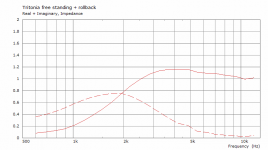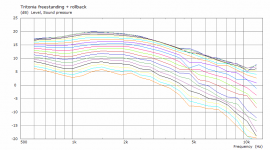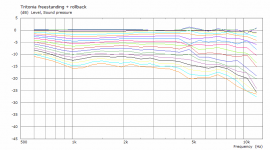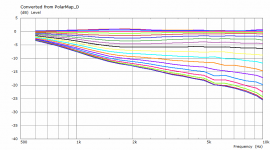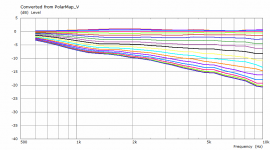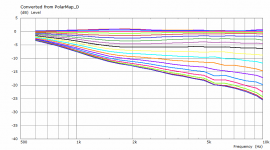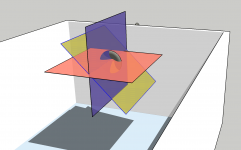Now that's what I'm talking about! The OS-SE may still be superior, but aesthetically the rollback Tritonia is going to blend into the average living space better. (imo)
As I said before, paint it the same colour as the wall, tuck it into the corner, and your significant other may not even notice it's there. (Maybe that's a stretch)
As I said before, paint it the same colour as the wall, tuck it into the corner, and your significant other may not even notice it's there. (Maybe that's a stretch)
Last edited:
Only a coarse calculation for now (still took over 1 hour) -BEM running... (don't hold your breath)
Ignoring the obvious numerical issues, it's probably not bad.
Attachments
I'm confused, if I remember correct the original tritonia was ruler flat on the different axis. Has your sim calculation changed to be more accurate? Is my memory wrong? Or is this worse?
Well it seems it will be pretty flat just on about any axis. Are we looking at the same pictures? In this case it doesn't really matter if it's normalized to 0, 10 or 20 deg (IIRC it was 15 before, I'm not sure).
The second picture is without normalization (i.e. constant acceleration drive).
I'm quite sure something could be done about the narrowing around 1 kHz but this non-axisymmetric optimization is a real PITA.
The second picture is without normalization (i.e. constant acceleration drive).
I'm quite sure something could be done about the narrowing around 1 kHz but this non-axisymmetric optimization is a real PITA.
Yes, that was an infinite baffle. Perhaps more stable calculation. The above is the very first attempt, including subdomain interface (will try to remove it).
Last edited:
When taking Fluids findings into account, is it far fetched to assume that the Tritonia in a minimally sized baffle with appropriate roundovers should perform similarly? Of course with the drawback of this only being the case for three quarters of its dimension. The interaction with the baffle below and the woofer in it will certainly make things worse. But how much?
A while back Marcel showed that the lip of the roundover ending where it does makes a difference, verses one that goes all the way back and around like a cabinet. I believe it was one of the most interesting things to come of this discussion thread.
It was also succinct when he said recently that sound waves don't always behave the way that we would intuitively expect... (paraphrase)
I've been on the fence about what I want to build for few months. I'm very much leaning towards this freestanding Tritonia... Thinking of going big ~500mm
It was also succinct when he said recently that sound waves don't always behave the way that we would intuitively expect... (paraphrase)
I've been on the fence about what I want to build for few months. I'm very much leaning towards this freestanding Tritonia... Thinking of going big ~500mm
Last edited:
Earl seemed to disagree quite strongly, but I’m not sure whether because I was being unclear (rectangular might be the wrong word for example) or because he thinks that you inherently compromise the acoustic properties of the no longer axisymmetric waveguide and are bound to lose more than you could possibly gain.
It's the later (except that I am not talking about asymmetry, only a continuous shape.) The rectangular waveguide will have severe problems along the diagonal, an elliptical won't. So in the H & V planes they are probably comparable, but along the diagonal they are not, but nobody ever looks at the diagonal response - I have, they get worse along the diagonal.
This is in principle the OS-SE formula in an enclosure - better but still not ideal, IMHO. That's what I meant with the round waveguide in a rectangular box - you simply can't avoid the flat parts on most of the surface:
Do you really think that I don't know this? I know that I mentioned the desirability of the most gradual curvature to the baffle very early on in this thread. I've know this for a long time. Regardless of the final slope there is always a smooth 2nd derivative (curvature) that fits the conditions. I am still not convinced of your argument.
But you can avoid the flat spots, I did this in a prototype. The curvature just varies out to the edge no matter where the edge is. That prototype was not a resounding success, yielding some benefits and some new aberrations - a very typical trial and error experience, not 100% advantageous.
Last edited:
It's the later (except that I am not talking about asymmetry, only a continuous shape.) The rectangular waveguide will have severe problems along the diagonal, an elliptical won't. So in the H & V planes they are probably comparable, but along the diagonal they are not, but nobody ever looks at the diagonal response - I have, they get worse along the diagonal.
I didn't realize this was the case. That's a significant drawback.
As I said before, paint it the same colour as the wall, tuck it into the corner, and your significant other may not even notice it's there. (Maybe that's a stretch)
Or put the speakers behind a curtain like I do. I have never understood peoples need to "see" "pretty" loudspeakers. Make them right, ugly or not and just hide them!!
It's not true - rectangular waveguides don't have to have problems on diagonal - I've just shown a counter-example above.
Actually, as probably many people who played with rectangular waveguides in Ath will confess, the diagonal polars are not seldom the best of them all... 🙂
(I'm sure there is plenty of waveguides with bad diagonals out there.)
(I'm sure there is plenty of waveguides with bad diagonals out there.)
A while back Marcel showed that the lip of the roundover ending where it does makes a difference, verses one that goes all the way back and around like a cabinet. I believe it was one of the most interesting things to come of this discussion thread.
Right, I remember that. I suppose the question is how much of a real world difference it will make. The bigger drawback of a baffled wg is certainly the baffle and woofer below.
The latter aside, if one would route the entire baffle (from say MDF) the rollback could also be done the same as freestanding and not 'just' a standard roundover. Then the difference is really just the termination at the end or lack thereof.
It seems clear to me that free standing is best, but it looks like the performance doesn't suffer too much when the waveguide is integrated properly into a baffle. That just opens up more speaker design possibilities without too much of an acoustic compromise.
The baffle / woofer below is still a problem though.
Honestly I don't think this all will make much difference subjectively - these are pretty small differences if all done right. It's just that I quite like the free standing looks (and no, I don't like the idea a of curtains in front of the speakers in our living room 🙂 )
- Home
- Loudspeakers
- Multi-Way
- Acoustic Horn Design – The Easy Way (Ath4)
